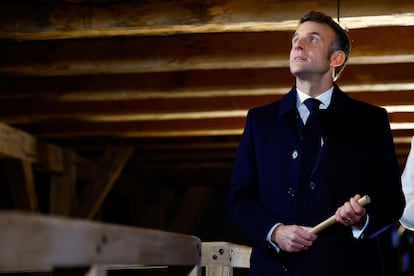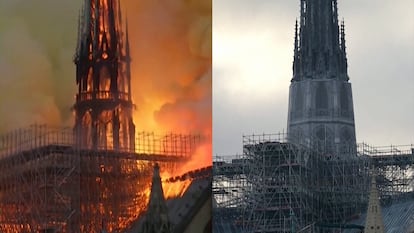The Notre Dame Cathedral, a symbol of Paris and a benchmark for Gothic art in Europe, will reopen its doors this Saturday, after a renovation that cost around 700 million euros and in which more than 2,000 workers participated. Nearly 1,500 attendees will participate in the reopening ceremony, the culminating moment of a reconstruction that began five years ago, after the devastating fire that engulfed one of the most visited monuments in Europe on April 15, 2018. Images of the flames gave the around the world and led to an unprecedented mobilization to recover the famous medieval temple from the 12th century, a World Heritage Site.
The fire, whose origin is still unknown, especially devastated the roof and the wooden structure of this masterpiece of Gothic art. In addition to damaging the building’s rose windows, a tower and the cross aisles, the flames toppled the 19th-century central spire, which fell onto the vaults. The French president, Emmanuel Macron, went to the site that day and promised its reconstruction in just five years. The result will be presented this afternoon before the eyes of the entire world, in a ceremony to which 40 heads of State and Government have been invited, including the president-elect of the United States, Donald Trump, and his Ukrainian counterpart, Volodymyr Zelensky.
Trump arrived at the Elysée this Saturday afternoon, on his first visit to a foreign country since his re-election, where he was received by Macron, with whom he exchanged a hug and several handshakes on the steps of the presidential palace. “It is a great honor for the French people to receive you. Welcome back,” the French president told the American magnate. Trump highlighted the “excellent relations” with Macron and before the cameras added: “The world seems to be a little crazy.”
Trump and Macron have held a meeting on the sidelines of the reopening of Notre Dame to discuss the tariffs that the American has threatened to impose on products from the EU, the war in the Middle East and the Russian invasion of Ukraine. Next, Zelensky joined this meeting of presidents, invited by Macron, to discuss the war situation in his country.
Meanwhile, hundreds of people have gradually gathered in the vicinity of the cathedral, amidst strong security measures, to follow the inauguration ceremony through a giant screen installed outside the temple.
The reopening of Notre Dame comes at a time when France is mired in a serious political crisis, after the fall of Michel Barnier’s government last Wednesday and with Macron’s popularity at historic lows.
The event will be presided over by the Archbishop of Paris, Laurent Ulrich, and by Macron himself inside the temple, after weather conditions forced the suspension of the activities planned in front of the monument’s façade. The French president made reconstruction a personal commitment. On Sunday a mass will be celebrated in the presence of 170 bishops and parish priests from the 106 parishes of the French capital. The public will be able to attend another religious ceremony in the afternoon and reservations for that day have already been sold out. In 2018, until the day of the fire, the cathedral attracted 12 million visitors, more than the Louvre museum, the palace of Versailles or the Eiffel tower.
First stone
Pope Alexander III laid the first stone of Notre Dame in 1163, a period in which the Church sought to exalt its power. Behind the project was Maurice de Sully, a son of lumberjacks appointed archbishop of Paris three years earlier. The religious never saw the finished work. He died in 1196 and the majestic cathedral acquired its present form in 1345.
Its location, on the Île de la Cité, on the banks of the Seine, has been dedicated to religion since ancient times, first pagan and then Christian. But the Gothic jewel, an icon of medieval art, has also been a symbol of political power in the country. Napoleon was crowned emperor in the temple in 1804, a scene immortalized by the painter Jacques-Louis David.
The imposing building has witnessed the tumultuous history of France. During the French Revolution, it became property of the State. When the abolition of Christian worship was decreed in 1793, it became a kind of pagan temple, with an altar dedicated to the goddess Reason. Abandoned and deteriorated, it ends up being the place where wine was kept for the army.

Victor Hugo’s novel Our Lady of Parispublished in 1831, struck Parisian public opinion. The writer stops the narrative to denounce the state of the cathedral. “No matter how beautiful it has been preserved over the years, it is difficult not to sigh, not to feel indignant at the countless degradations and mutilations that time and man have simultaneously inflicted on this venerable monument,” he writes.
The architect Eugène-Emmanuel Viollet-le-Duc will be in charge of its renovation in the 19th century, which will last more than 20 years. Passionate about the Middle Ages, he is responsible for the current appearance of the temple. He added the 93-meter arrow that collapsed during the fire. He also incorporated the famous chimeras into the building, which became true symbols of the cathedral.
Massive donations
More than 800 years after its construction began, Notre Dame has regained its splendor. After the fire, hundreds of artisans and 250 companies participated in its renovation thanks to massive donations from around the world, which reached 840 million euros. There were 340,000 contributions from more than 150 countries.
The first tasks consisted of removing the rubble and consolidating the construction. Then the renovation work could begin. The result – the work of architects, engineers, archaeologists, artisans, restorers and scientists – is a completely reconstructed roof, a pristine 60-meter nave and modern furniture, with 1,500 new chairs. The renovation used ancient techniques, but also included more modern tools such as drones or state-of-the-art scanners.
The arrow, with a rooster on the tip, could already be seen for weeks, as could the eight bells, which rang again for the first time in five years on November 8. All of them were cleaned and two of them, which were affected by the heat of the flames, were restored. The organ, the true voice of the cathedral, has also been dismantled and restored. The instrument, with 8,000 tubes, was not affected by the flames, but suffered damage from high temperatures and lead contamination.

